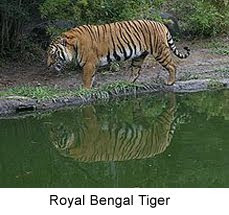SUNDARBANS
The forest lies at the feet of the Ganges and is spread across areas of Bangladesh and West Bengal, India, forming the seaward fringe of the delta. The seasonally-flooded Sundarbans freshwater swamp forests lie inland from the mangrove forests. The forest covers 10,000 km2 of which about 6,000 are in Bangladesh.The Sundarbans is intersected by a complex network of tidal waterways, mudflats and small islands of salt-tolerant mangrove forests. The area is known for the eponymous Royal Bengal Tiger (Panthera tigris), as well as numerous fauna including species of birds, spotted deer, crocodiles and snakes. It is estimated that there are now 500[citation needed] Bengal tigers and about 30,000 spotted deer in the area. Sundarbans was designated a Ramsar site on May 21, 1992. The fertile soils of the delta have been subject to intensive human use for centuries, and the ecoregion has been mostly converted to intensive agriculture, with few enclaves of forest remaining. The remaining forests, together with the Sundarbans mangroves, are important habitat for the endangered tiger. Additionally, the Sundarbans serves a crucial function as a protective flood barrier for the millions of inhabitants in and around Kolkata (Calcutta) against the result of cyclone activity.
The mangrove-dominated Ganges Delta – the Sundarbans - is a complex ecosystem comprising one of the three largest single tract of mangrove forests of the world. Shared between two neighbouring countries, Bangladesh and India, the larger part (62%)is situated in the southwest corner of Bangladesh. To the south the forest meets the Bay of Bengal; to the east it is bordered by the Baleswar River and to the north there is a sharp interface with intensively cultivated land. The natural drainage in the upstream areas, other than the main river channels, is everywhere impeded by extensive embankments and polders. The Sundarbans was originally measured (about 200 years ago) to be of about 16,700 km². Now it has dwindled to about 1/3 of the original size. The total land area today is 4,143 km² (including exposed sandbars: 42 km²) and the remaining water area of 1,874 km² encompasses rivers, small streams and canals. Rivers in the Sundarbans are meeting places of salt water and freshwater. Thus, it is a region of transition between the freshwater of the rivers originating from the Ganges and the saline water of the Bay of Bengal
It became inscribed as a UNESCO world heritage site in 1997, but while the Bangladeshi and Indian portions constitute the same continuous ecotope, these are separately listed in the UNESCO world heritage list as the Sundarbans and Sundarbans National Park, respectively.


